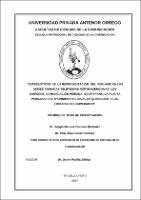| dc.contributor.advisor | Padilla Zuñiga, Dante | |
| dc.contributor.author | Chirinos Meléndez, Sergio Manuel | |
| dc.contributor.author | Sotelo Ramirez, Polk Alan | |
| dc.creator | Chirinos Meléndez, Sergio Manuel | |
| dc.date.accessioned | 2018-02-14T21:31:56Z | |
| dc.date.available | 2018-02-14T21:31:56Z | |
| dc.date.issued | 2017 | |
| dc.identifier | T_COMU_586 | |
| dc.identifier.other | T046_73022884T | |
| dc.identifier.other | T046_48003855T | |
| dc.identifier.uri | https://hdl.handle.net/20.500.12759/3650 | |
| dc.description.abstract | Esta investigación pretende identificar los estereotipos del peruano
representado en las series animadas televisivas norteamericanas. Se empleó
una metodología cualitativa y para ello se realizó un análisis sobre la
aplicación de unas fichas de observación hacia los elementos de la muestra
seleccionada por representatividad: South Park, Los Simpsons, Los
Thornberrys y Las locuras del emperador; series animadas que presentan a
los personajes peruanos en unos de sus capítulos, así mismo se realizó
entrevistas a especialistas sobre el problema. Finalmente se demostró que el
contenido de las series animadas televisivas depende del público al que va
dirigido. La mayoría de las series animadas expone a un peruano muy
apegado a sus raíces culturales, muy protector, ancestral y ‘mágico’, así
mismo como un personaje que busca cualquier forma de salir adelante para
progresar; esto no ocurre en las series destinadas al público juvenil con
categoría +18, mostrando a un peruano insoportable para el resto, pasivo,
poco expresivo, débil y de origen serrano. | es_PE |
| dc.description.abstract | This research aims to identify the stereotypes of peruvian represented in the
American television animated series. A qualitative methodology was employed
and to do an analysis of an application of observation forms to the elements of
the sample selected for representation was made: South Park, The Simpsons
and The Wild Thornberrys, The Emperor's New Groove, animated series with
Peruvian characters in each chapters; also have interviews with experts about
the problem. Finally it was shown that the content of television animated
series depends on the audience target. Most animated series exposed to a
protective, ancestral and 'magical' peruvian, very attached to their cultural
roots, as a character who looks for any way forward to progress; this does not
happen in the series aimed at young people with +18 category, showing a
passive peruvian, undemonstrative, weak and serrano origin, unbearable for
the rest. | en_US |
| dc.format | application/pdf | es_PE |
| dc.language.iso | spa | es_PE |
| dc.publisher | Universidad Privada Antenor Orrego | es_PE |
| dc.relation.ispartofseries | T_COMU_586 | |
| dc.rights | info:eu-repo/semantics/openAccess | es_PE |
| dc.rights.uri | https://creativecommons.org/licenses/by/4.0/ | es_PE |
| dc.source | Universidad Privada Antenor Orrego | es_PE |
| dc.source | Repositorio Institucional - UPAO | es_PE |
| dc.subject | Series Animadas Televisivas | es_PE |
| dc.subject | Estereotipos | es_PE |
| dc.title | Estereotipos de la representación del peruano en las series animadas televisivas norteamericanas: los simpsons, comunicación perdida: south park, la flauta peruana; los thornberrys, nigel es quien sabe y las locuras del emperador | es_PE |
| dc.type | info:eu-repo/semantics/bachelorThesis | es_PE |
| thesis.degree.level | Título Profesional | es_PE |
| thesis.degree.grantor | Universidad Privada Antenor Orrego. Facultad de Ciencias de la Comunicación | es_PE |
| thesis.degree.name | Licenciado en Ciencias de la Comunicación | es_PE |
| thesis.degree.discipline | Ciencias de la Comunicación | es_PE |
| dc.subject.ocde | https://purl.org/pe-repo/ocde/ford#5.08.00 | es_PE |
| renati.type | https://purl.org/pe-repo/renati/type#tesis | es_PE |
| renati.level | https://purl.org/pe-repo/renati/level#tituloProfesional | es_PE |
| dc.publisher.country | PE | es_PE |


